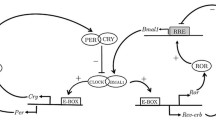Abstract
We theoretically study periodic oscillation and its period of a circadian rhythm model of Neurospora and provide the conditions for the existence of such a periodic oscillation by the theory of competitive dynamical systems. To present the exact expression of the unique equilibrium in terms of parameters of system, we divide them into eleven classes for the Hill coefficient \(n=1\) or \(n=2\), among seven classes of which nontrivial periodic oscillations exist. Numerical simulations are made among the seven classes and the models with the Hill coefficient \(n=3\) or \(n=4\) to reveal the influence of parameter variation on periodic oscillations and their periods. The results show that their periods of the periodic oscillations are approximately 21.5 h, which coincides with the known experiment result observed in constant darkness.











Similar content being viewed by others
References
Beadle, G.W., Tatum, E.L.: Genetic control of biochemical reactions in Neurospora. PNAS 28(11), 234–243 (1941)
Bodenstein, C., Heiland, I., Schuster, S.: Temperature compensation and entrainment in circadian. Phys. Biol. 9(3), e036011 (2012)
Diekmann, C., Brody, S.: Circadian rhythms in Neurospora crassa: oligomycin-resistant mutations affect periodicity. Science 207(4433), 896–898 (1980)
Drescher, K., Cornelius, G., Rensing, L.: Phase response curves obtained by perturbing different variables of a 24 hr model oscillator based on translational control. J. Theor. Biol. 94(2), 345–353 (1982)
Francois, P.: A model for the Neurospora circadian clock. Biophys. J. 88(4), 2369–2383 (2005)
Gedeon, T.: Oscillations in monotone systems with a negative feedback. SIAM J. Appl. Dyn. Syst. 9(1), 84–112 (2010)
Goldbeter, A.: A model for circadian oscillations in the Drosophila period protein (PER). Proc. Biol. Sci. 261(1362), 319–324 (1995)
Gonze, D., Abou-Jaoude, W.: The Goodwin model: behind the Hill function. PLoS One 8(8), e69573 (2013)
Gonze, D., Leloup, J.C., Goldbeter, A.: Theoretical models for circadian rhythms in Neurospora and Drosophila. C. R. Acad. Sci. 323(1), 57–67 (2000)
Goodwin, B.C.: Oscillatory behavior in enzymatic control. Adv. Enzyme Reg. 3, 425–439 (1965)
Gérard, C., Gonze, D., Goldbeter, A.: Dependence of the period on the rate of protein degradation in minimal models for circadian oscillations. Philos. Trans. A Math. Phys. Eng. Sci. 367(1908), 4665–4683 (2009)
Hastings, J.W., Schweiger, H.G.: The molecular basis of circadian rhythms: report of the Dahlem Workshop on the Molecular Basis of Circadian Rhythms. Berlin 1975, November 3 to 7. Abakon Verlagsgesellschaft (1976) (in Komm.)
Hirsch, M.W.: Systems of differential equations which are competitive or cooperative: I. limit sets. SIAM J. Math. Anal. 13(2), 167–179 (1982)
Hong, C.I., Jolma, W., Loros, J., Dunlap, J., Ruoff, P.: Simulating dark expressions and interactions of FRQ and wc-1 in the Neurospora circadian clock. Biophys. J. 94(4), 1221–1232 (2008)
Leloup, J.C., Gonze, D., Goldbeter, A.: Limit cycle models for circadian rhythms based on transcriptional regulation in Drosophila and Neurospora. J. Biol. Rhythms 14(6), 433–448 (1999)
Loros, J.J., Dunlap, J.C.: Genetic and molecular analysis of circadian rhythms in Neurospora. Annu. Rev. Physiol. 63(1), 757–794 (2001)
Mao, X.Y., Li, X.P.: Population dynamical behavior of non-autonomous Lotka-Volterra competitive system with random perturbation. Discrete Cont. Dyn. 24(2), 523–545 (2009)
McKelvey, J.P.: Simple transcendental expressions for the roots of cubic equations. Am. J. Phys. 52(3), 269–270 (1984)
Nickalls, R.W.D.: A new approach to solving the cubic: Cardan’s solution revealed. Math. Gaz. 77(480), 354–359 (1993)
Ruoff, P., Rensing, L.: The temperature compensated Goodwin model simulates many circadian clock properties. J. Theor. Biol. 179(4), 275–285 (1996)
Ruoff, P., Vinsjevik, M., Monnerjahn, C., Rensing, L.: The Goodwin model: simulating the effect of light pulses on the circadian sporulation rhythm of neurospora crassa. J. Theor. Biol. 209(1), 29–42 (2001)
Shi, J.C., Li, Q.S.: Sustainment and controlment of noise-induced circadian oscillations in Neurospora: noise and external signal effects. Int. J. Theor. Phys. 46(10), 2351–2365 (2007)
Smith, H.L.: Monotone Dynamical Systems: an Introduction to the Theory of Competitive and Cooperative Systems, vol. 41. Math. survey Monogr, AMS, Providence, R.I. (1995)
Sun, M.R., Wang, Y., Xu, X., Yang, L.: Dynamical mechanism of circadian singularity behavior in Neurospora. Phys. A 457(1), 101–108 (2016)
Tonnelier, A.: Cyclic negative feedback systems: what is the chance of oscillation? Bull. Math. Biol. 76(5), 1155–1193 (2014)
Tseng, Y.Y., Hunt, S.M., Heintzen, C.: Comprehensive modelling of the Neurospora circadian clock and its temperature compensation. PLoS Comput. Biol. 8(3), e1002437 (2012)
Xie, Z., Kulasiri, D.: Modelling of circadian rhythms in Drosophila incorporating the interlocked PER/TIM and VRI/PDP1 feedback loops. J. Theor. Biol. 245(2), 290–304 (2007)
Author information
Authors and Affiliations
Corresponding author
Ethics declarations
Conflict of Interest
The authors declare that they have no conflict of interest.
Additional information
This work was supported by the National Natural Science Foundation of China (NSFC) (No. 11771295).
Rights and permissions
About this article
Cite this article
Feng, M., Zhang, C. On Periodic Oscillation and Its Period of a Circadian Rhythm Model. Commun. Appl. Math. Comput. 4, 1131–1157 (2022). https://doi.org/10.1007/s42967-021-00146-1
Received:
Revised:
Accepted:
Published:
Issue Date:
DOI: https://doi.org/10.1007/s42967-021-00146-1




